![]()
![]()
![]()
Use LEFT and RIGHT arrow keys to navigate between flashcards;
Use UP and DOWN arrow keys to flip the card;
H to show hint;
A reads text to speech;
157 Cards in this Set
- Front
- Back
|
The ability of organisms to withstand conditions is determined by: |
Genetics |
|
|
What is the large-scale component of control for organisms? |
Chromosomes |
|
|
These usually occur as pairs in the nucleus. They control the amount of genetic information in the organism. The more of these you have, the more genetic information you have. They are composed of DNA. |
Chromosomes |
|
|
These are specific sequences of amino acids on the chromosome that have specific functions. They code for enzymes that adapt for specific functions. |
Gene |
|
|
This is the specific location of the gene on the chromosome, or the "address" of the amino acid pairs that perform a specific function |
Locus |
|
|
Chromosome pairs are usually copies. When the chromosomal pairs code for the exact same amino acid sequence at the same locus, they are referred to as: |
Homozygous |
|
|
When chromosomal pairs code for different amino acid sequences at the same locus, they are referred to as: |
Heterozygous |
|
|
This is the total number of heterozygous chromosomes. It determines how much genetic information is available. |
Heterozygosity |
|
|
All homozygous chromosomal pairs have this restriction: |
Finite adaptability |
|
|
This is the symbol indicating the amount of genetic material available to the organism. |
H-bar |
|
|
The alternate forms of the same gene located at a specific locus on a specific chromosome. |
Allele |
|
|
This codes for an enzyme of a specific function. |
Allozyme |
|
|
How is heterozygosity measured? |
Gel electrophoresis |
|
|
Through gel electrophoresis, starch gels, acrylamides or thidium bromides are used and sort alleles by charge and size. After the gel is run, it is stained for this. |
A specific allozyme |
|
|
If only one allozyme appears after gel electrophoresis, it is [homozygous/heterozygous]. |
Homozygous because it is carrying the same genetic information at the same location. |
|
|
What is the percentage of heterozygosity in the polar region? |
2%? or 21% |
|
|
Which type of allele will be functional in a very stable environment, such as a tropical environment? |
An allele capable of very specific adaptations. |
|
|
Recall the phrase, "Stability permits ____" |
Complexity
|
|
|
Recall the phrase, "Chaos requires _____" |
Generalization |
|
|
This is multiple species of the same genus. |
Congeneric species |
|
|
What does the Law of Competitive Exclusion say? |
*No congeneric species will exist in the same environment *The closer organisms are genetically, the more they will tend to exclude each other and compete *If organisms with the same genetic basis are in the same environment, they are competing for different trophic resources. |
|
|
Three organisms of a similar genetic basis have three feeding types: one eats particulates, one captures food from the water column, and one siphons organics from the top of the sand. This is an example of: |
Genetic variability |
|
|
This type of reproduction occurs through mitosis. |
Asexual |
|
|
What are some disadvantages of asexual reproduction? |
*It does nothing for genetic variability *The offspring are an identical genetic copy of their parents, so negative traits will be transmitted 100% |
|
|
Which organisms are capable of asexual reproduction? |
Bacteria, sponges, colonian organisms, bryozoa, porifera, corals |
|
|
This type of reproduction occurs through meiosis. |
Sexual reproduction |
|
|
What are some advantages of sexual reproduction? |
*Increased genetic variability *Dispersal of genetic information increased (organisms will float for several months) |
|
|
What are some advantages of asexual reproduction? |
*Good genes passed onto later generations 100% *Lots of organisms are produced at a lower cost *Organisms are able to take advantage of positive niches more quickly |
|
|
What are the three strategies of sexual reproduction? |
Planktrophic, lecithotrophic, brooding |
|
|
In this strategy of reproduction, organisms release their larva into the water column at very low maturity. The released larva feed in the water column and mature, then settle and metamorphose. |
Planktrophic |
|
|
What are some advantages of planktrophic reprodution? |
*Very low cost to the parent *Can afford to release many individuals *High dispersal rate |
|
|
What is the disadvantage to planktrophic reproduction? |
*Very low rate of survival |
|
|
In this strategy of sexual reproduction, the organism forms a larva and produces a "sack lunch" for each larva before they are released. This eliminates the need for the larva to feed in the water column. |
Lecithotrophic |
|
|
What are some details of lecithotrophy? |
*Organisms spend less time in the water column *Intermediate reproductive cost *Dispersal potential is intermediate |
|
|
In this reproductive strategy, organisms maintain offspring to a very high level of maturity before releasing them. A recognizable species forms. |
Brooding |
|
|
What is an advantage to brooding? |
*High success in unstable environments |
|
|
What are disadvantages of brooding? |
*Very high reproductive cost *Few offspring produced *Dispersal does not occur |
|
|
What is the end result of all sexual reproductive strategies? |
If one organism survives, genetic information can be carried to the next generation. |
|
|
Where did Dr. Zumwalt do his Masters work? |
Eniwetok |
|
|
This is a 3D Structure made of fused skeletons of organisms. |
Reef |
|
|
This is a large sediment trap. |
Lagoon |
|
|
This is a ring of islands perched on an extinct volcano. |
Atoll |
|
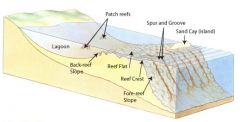
|
Know this diagram. |
|
|
This is an area in which pieces of the reef break off and tumble down the hill. |
Rubble zone |
|
|
This is an area in which waves energy is absorbed. |
Ridge and Rubble area |
|
|
This is the highest living point, composed of coral and algae. |
Lithothamnion ridge |
|
|
This is the end of the ridge system; the end is very deep. |
Leeward wall |
|
|
This forms when coral grows as fast as the lagoon sinks. |
Pinnacle |
|
|
This substance caps off inactive volcanoes. |
Limestone |
|
|
When volcanoes are active, there is little coral growth. As the volcano erodes, you get this. |
Fringing reef systems |
|
|
What are fringing reef systems composed of? |
Corals |
|
|
When the volcano is no longer active, it becomes very dense and this occurs. |
It sinks. |
|
|
If coral grows quickly enough to keep up with the sinking volcano, you get this. |
A ring of islands around a lagoon |
|
|
In this area, pieces of the reef tumble down the hill. Most of the reef pieces die. Sharks are quite populous in this area. |
Rubble zone |
|
|
In this area, sharks swim around corners and attack. |
Ridge and rubble |
|
|
This type of shark is very passive. It hides in holes in the reef and is capable of pumping water through its gills while moving. |
White tip shark |
|
|
This area has very low visibility and a very high shark concentration. |
Lithothamnion ridge |
|
|
In this area, there are holes, boulders, and sea urchins. The urchins are aligned precisely with 1/3 of their spines overlapping. |
Reef flat |
|
|
Why are urchins arranged with their spines overlapping? |
For reproductive success |
|
|
How do urchins initiate reproduction? |
They release an enzyme to signal others to release gametes in reduced water volume to increase the chance of gamete fusion. |
|
|
In this area, there is a rubble zone with pieces of coral. The accumulation of coral is at the base of all islands, and sand is stacked onto these pieces to form islands. |
Inside of the reef flat |
|
|
In this area, there are very fragile forms protected by the islands that absorb wave energy. |
Lagoon |
|
|
What is the feeding type of corals? |
They contain plantlike organisms living in their tissues. All colonies are formed by mitosis. They all have the same genetic information. |
|
|
This area is surrounded by sand. During storms, pieces of this are broken off and litter the ground. The pieces grow upward and outward. |
Base of the patch reef |
|
|
Why do corals grow outward? |
To display as much tissue to sunlight as possible |
|
|
About how many organisms can a small piece of coral contain? |
150+ |
|
|
What does it mean when corals are white? |
Starfish have consumed all of their living tissue and this coral is dead. |
|
|
These are over 8 feet long. They have huge siphons. They are facultative autotrophs. The use energy to grow and they can snap shut on humans, but they take five minutes to close. |
Killer clams |
|
|
This phylum contains chrinoids/sea baskets. Their subphylum is chrinozoid. They are mobile and they extend their feeding apparatus into corals. They are suspension feeders that live inside pinnacles. |
Echinodermata |
|
|
These organisms are great at camouflage. They have a set of spines that extend from their backs that can be raised. The base of the spine has a very deadly poison sack that can kill humans in 20 minutes. |
Stonefish |
|
|
These organisms are lophophore filter feeders and are sessile. |
Brachiopods |
|
|
In this area, coral types change. This area has 1800+ feet of water. Very good visibility. |
Leeward wall |
|
|
This is a circumstance in which nitrogen in the air can become very toxic with depth. For every 33 feet, you experience the equivalent of consuming one martini. |
Nitrogen narcosis |
|
|
Outline the predictions of speciation and extinction in both conventional and valentinian perspectives. |
Speciation Extinction Predictions
Conventional Stable low high Unstable high low
Valentinian Stable high high or low Unstable low low |
|
|
In unstable environments, organisms have this type of alleles. |
Generalized
|
|
|
In stable environments, organisms have this type of alleles. |
Specialized |
|
|
Polar regions are [physically/biologically] accomidated. |
Physically |
|
|
Tropical regions are [physically/biologically] accomidated. |
Biologically |
|
|
No genetic variability means: |
No speciation |
|
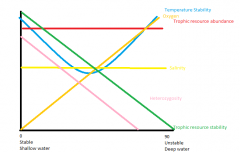
|
*Salinity is stable by latitude in the open ocean *Salinity is so low because of fresh water river system influence *Warmer water cannot carry as much oxygen *The more organisms you have, the more subdivision of resources occurs, and the fewer species you will have. |
|
|
Refer to the chart. Which theory, conventional or valentinian, is correct and why? |
*Using fossil records, most speciation and extinction occurs in tropical regions. *Very little extinction and speciation occurred in polar regions because they do not have much genetic variability and have hearty alleles *According to fossil records, the valentinian model is supported the most. |
|
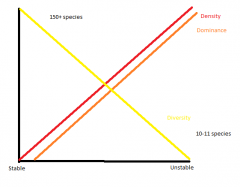
|
*Density is parallel to dominance *Dominance and density are inversely proportional to diversity |
|
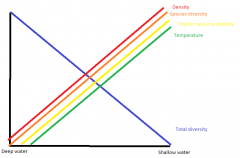
|
*Total resource abundance controls the density of organisms *The more food you have, the more organisms you can support *The more dense organisms are, the more measured diversity you will have |
|
|
This person designed the epibenthic sled. |
Bob Hesler |
|
|
What controls heterozygosity? |
Stability of trophic resources |
|
|
This is the total amount of genetic information available to an individual. |
Genotype |
|
|
This is the total amount of genetic information available to the species. |
Genome |
|
|
This is the physical/observable characteristics determined by the genotype. |
Phenotype |
|
|
This is the development from larva to adult, relying on the environmental factors and responding to these factors by choosing the best form under those conditions. |
Otogeny |
|
|
This is the physical characteristics that occur as a result of environmental changes. For example, coral with one genotype was clipped and glued to a plate. After a while, one genera and five species were identified. This is because the coral expressed differently according to the environment, looking like other species. |
Ecophenotype |
|
|
This law states that the yield is proportional to the amount of the most limiting nutrient, whatever that nutrient may be. |
Liebig's Law of the Minimum |
|
|
What are the two theories explaining the control of organism distribution in the ocean? |
Synecology and Autecology |
|
|
This theory of organism control states that biological interactions define the organisms in the community. (Biologically accommodated community) |
Synecology |
|
|
This theory of organism control states that organisms in a community are controlled by physical interactions. (Physically accommodated community) |
Autecology |
|
|
Where is synecology most likely to be correct? |
In the tropics because they have higher stability of physical parameters. |
|
|
Where is autecology most likely to be correct? |
Temperate and Polar regions because they are very unstable environments. |
|
|
Which theory fits the oceans the best? |
Synecology because the oceans are very stable. |
|
|
What is the heterozygosity in tropical regions? |
High because the organisms have specialized alleles for biological accommodations. |
|
|
What is the heterozygosity in polar and temperate regions? |
Low, because organisms have highly generalized alleles. |
|
|
What is the most complex community? |
(Mytilus edulis) and barnacles (Balanus improvisus) community |
|
|
What makes the (Mytilus edulis) and barnacles (Balanus improvisus) community so complex? |
*In part, the system is physically accommodated. *Certain temperature, oxygen levels, and salinity ranges rarely change *The community is biologically accommodated for the barnacles because they provide substrate for invertebrates *Shallow marine sites are disturbed very often, creating new substrate *Progression depends on what is reproducing at the time *Barnacles are very aggressive and can dominate very quickly |
|
|
What would you expect a mudflat to be, accommodation wise? |
Physically accommodated because there is a relatively low density and diversity, defined by its salinity, desiccation, and temperature changes. |
|
|
How do organisms change over time? |
Differential Reproductive Success |
|
|
Who tried to publish Darwin's work first? They worked together to create a new idea of evolution. |
Wallace |
|
|
What are Darwin's three main observations? |
1. Organisms tend to overreproduce. They produce more offspring than can survive in that environment 2. Populations will stay the same 3. Variations occur within species |
|
|
Give some examples of Darwin's first observation. (Organisms tend to over-reproduce, creating more offspring than can survive in the environment) |
*Mola Mola (Ocean Sunfish) are the worst offenders. They get very large and lay 100 eggs per 100 lbs of body weight. They can weigh over a ton. How do they survive? Lots of reproduction
*Bullfrogs lay 6-8 egg masses with 10,000 eggs each, but not many survive |
|
|
Explain why Darwin's second observation makes sense. (Population will stay the same) |
Because there is a carrying capacity on the environment. The environment can only supply enough food for so many species. |
|
|
Give an example of Darwin's third observation (Variations occur within species) |
Darwin's finches. We recognize lots of human variation because we are humans. |
|
|
What were Darwin's two conclusions based on his observations? |
1. Competition for finite resources must occur (based on observations 1 and two) 2. The outcome of competition is controlled by variation (Fitness of organisms; natural selection) |
|
|
How did Darwin define fitness? |
The amount of offspring that reach reproductive age AND reproduce successfully. |
|
|
What was Lamark's theory of organisms? |
Organisms acknowledge the need for certain things in their environment and respond to that need. The need is passed on.W |
|
|
What is the problem with Lamark's theories? |
Learned characteristics are not heritable |
|
|
How would Lamark's observations be explained by Darwin? |
Species that have adapted to the needs of their environment got enough food to survive. *Selective breeding* |
|
|
How do communities change? |
Ecologic succession |
|
|
This is a model to explain how communities change throughout time. |
Ecologic succession |
|
|
Explain ecologic succession, explaining the seres involved. |
When a substrate or area is destroyed, the first thing to come around after the destructive event follows ordered steps of "seres".
Weedy sere -> Perennial sere -> Softwood sere -> Hardwood sere |
|
|
What is the alternate model to ecologic succession? |
Faunal Progression |
|
|
Explain the faunal progression experiment. |
A student took racks and set up 12 plates per rack. He put the racks on 10-15 places in a salt marsh (Intertidal mud flat) |
|
|
What were the two failures of the faunal progression experiment? |
*Using plastic/plexiglass plates: organisms would not land on them *Using slate shingles, nothing landed |
|
|
What was the successful result of the faunal progression experiment? |
Bacteria accumulated on the slates. Larva landed and morphose on the plates. Looking at the plates, you would see whatever organisms were reproducing at that time. Plates that had been out for one year had representation of all organisms in the area. |
|

|
*Annual species will die off in the winter and give up that substrate (A+D) *Since A and D were annuals, they are gone. B and C asexually reproduce and try to take over the available area created by A and D no longer occupying the area. *B is a perennial. Eventually, the longest living form will be dominant. Assume C can live a long time. |
|
|
What determines a species' success in a particular environment? |
1. Time and reproduction 2. Competitiveness 3. Longevity 4. Longest lived species will prevail 5. Next disturbance |
|
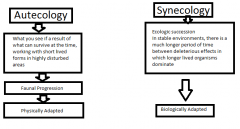
|
Dramatically opposed ideas overlap, as shown here. There is a huge gradient between these events. |
|
|
Explain the trophic chain. |

|
|
|
In this trophic resource organization, there many species of primary producers. The first level of predators can eat most herbivores, and herbivores can eat most primary producers. |
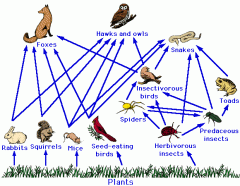
Food web |
|
|
What are the two alternatives of trophic resource systems? |
*Synecology - chain - only possible in stable environments
*Autecology - food web - unstable bc one food type may not be there |
|
|
Which system has the greatest potential for extinction? |
Food chain |
|
|
Historically, how are trophic systems are visualized as a: |
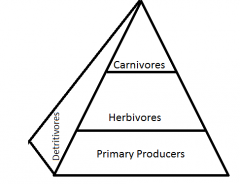
Pyramid |
|
|
Why is the trophic pyramid structured as such? |
Primary producers make up the most biomass |
|
|
What is wrong with the trophic pyramid scheme? |
There is no room for omnivores or other organisms that fall into multiple categories |
|

|
This quantifies the flow of energy by feeding types.
*Primary producers are photoautotrophs or chemoautotrophs *Filter feeders feed on planktonic autotrophs *Suspension feeders extend their apparatus into water and capture food *Grazers move along the column and eat whatever they come into contact with
All organisms end up in the decomposition cycle, breaking them into primary nutrients to be fed on by primary producers
|
|
|
Most photoautotrophs are this type of organism. |
Protista |
|
|
This term describes organisms that live in the water column above the bottom. |
Pelagic |
|
|
This is a type of pelagic organism that can swim well enough to change its relative position in the water column. |
Nectonic |
|
|
This is a type of pelagic organism that cannot swim well enough to change its relative position |
Planktonic |
|
|
This is a type of planktonic pelagic organism that is capable of photosynthesis. |
Phytoplankton |
|
|
This is a type of planktonic pelagic organism that is not capable of photosynthesis |
Zooplankton |
|
|
This term describes an organism that lives on or in the bottom of the ocean. |
Benthic |
|
|
This is a type of benthic organism that lives on the bottom. |
Epifaunal |
|
|
This is a type of epifaunal benthic organism that fastens permanently to the bottom. |
Sessile |
|
|
This is a type of epifaunal benthic organism that can move freely across the bottom. |
Vagile |
|
|
This is a type of epifaunal benthic organism that does not move freely or fasten permanently to the bottom. |
Quiescent |
|
|
This type of benthic organism lives in the bottom. |
Infaunal |
|
|
This type of infaunal benthic organism moves through sediments. |
Vagrant |
|
|
This type of infaunal benthic organisms live in permanent burrows. |
Burrowing |
|
|
What is the ecologic position of brachiopods? |
Sessile epifaunal benthic (epibenthic) |
|
|
What is the opposite of an omnivore? |
Obligate predator |
|
|
What is the ecologic position of sharks in the water column? |
Nectonic pelagic |
|
|
What is the ecologic position of animals that live in a burrow their entire lives? |
Burrowing infaunal benthos |
|
|
What is the ecologic position of the blue crab? |
Vagile epibenthos, sometimes nectonic |
|
|
What is the ecologic position of a euphasid or krill? |
Zooplankton |
|
|
Which organisms are autotrophs? |
Primary producers |
|
|
What organisms are heterotrophs? |
Everything other than primary producers |
|
|
What is the ecologic position of organisms that burrow through sediments? |
Vagrant epibenthic |
|
|
What is the ecologic position of oysters in the water column? |
Quiescent epifaunal; start as sessile |
|
|
What is the ecologic position of sea urchins? |
Vagile epifaunal, but they do not move often |
|
|
What is the ecologic position of sand dollars? |
Vagrant infaunal |

